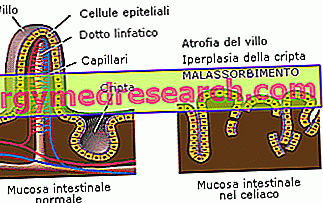We speak of malabsorption to indicate the deficient passage of one or more products of digestion from the gastrointestinal tract to the blood.
Malabsorption, often associated with maldigestion, can be:
- selective (relative to a single nutrient, as in lactose intolerance);
- partial (relative to a more or less wide part of nutrients, as in the a-Beta-lipoproteinemia (rare hereditary disease that interferes with the normal absorption of lipids);
- total (typical of celiac disease and other diseases or conditions that damage the mucosa of the small intestine).
Symptoms of malabsorption

Causes of malabsorption
The causes potentially responsible for malabsorption are multiple and rather difficult to classify. Some of these, such as abetalipoproteinemia, have family origins, while others are acquired (following infections, taking specific drugs, surgical operations, traumas, etc.). Among all, celiac disease is the most common hereditary disease associated with malabsorption, followed by cystic fibrosis.
Infectious malabsorption syndromes include traveler's diarrhea, intestinal flu, tropical sprue, enteric tuberculosis and intestinal parasites. Among those due to an enzyme deficiency, we recall the intolerance to lactose and other sugars such as fructose and sucrose; in this case the malabsorption has a predominantly genetic basis. Other possible causes of malabsorption include: imbalances in the intestinal bacterial flora (dysbiosis, bacterial contamination syndrome of the small intestine), Crohn's disease, ulcerative colitis, neoplasms of the digestive system, pancreatic diseases (pancreatitis, pancreatic insufficiency), diseases of the liver and biliary tract (calculosis, liver failure, biliary atresia), damage caused by radiant therapies, surgical resection or gastrointestinal bypass (for example, to remove tumors or reduce food intake in the obese patient), overeating ( for example, vitamin megadoses, surplus bran and other dietary fiber, over-abundant and variegated meals), certain drugs or supplements (let's think for example of laxatives and anti-obesity drugs such as orlistat and acarbose), alcohol abuse, atrophic gastritis, hypochloridria / achlorhydria.
Malabsorption diagnosis
Based on the observation of the symptoms and the individual medical history, the doctor prescribes the most suitable diagnostic tests. Blood tests can for example highlight specific deficiencies, anemic forms, reduced blood coagulation capacity, possible markers of liver and pancreatic function, or abnormal antibodies. The examination of the stools allows to identify the causative agent responsible for the forms of infectious malabsorption, but also to quantify the fat levels for the diagnosis of steatorrhea (lipid malabsorption) and those of chymotrypsin to assess pancreatic function. Invasive imaging and diagnostic techniques (barium enema, endoscopy, colonoscopy, intestinal mucosa biopsy, endoscopic retrograde cholangio-pancreatography etc.) can be conducted to highlight anatomical alterations of the various tracts of the digestive tract and biliary tract. Instead, so-called breath tests or breath tests are performed to identify microbial alterations and enzymatic deficits responsible for malabsorption.
Care and treatment
Treatments and treatments obviously depend on the causes responsible for malabsorption. Specific dietary supplements may be required to fill nutritional deficiencies, which in the most serious cases will be performed by venous route (parenteral nutrition); in the presence of enzyme deficiencies supplementation of animal digestive enzymes (pancreatin) or vegetables (bromelain and papain) may be useful; exclusion diets can be useful in the presence of food intolerances and celiac disease (avoiding, for example, foods containing gluten); the use of antibiotics on the one hand and probiotics on the other can be useful to restore the normal balance of the intestinal bacterial flora in malabsorption syndromes due to or associated with dysbiosis.



